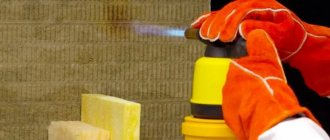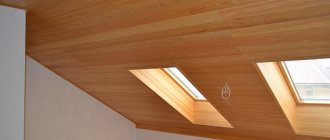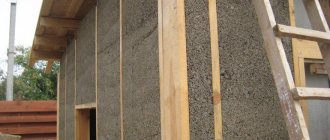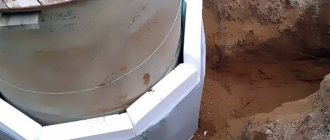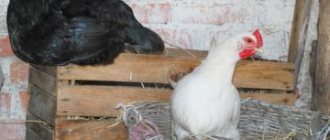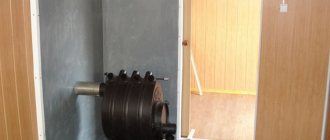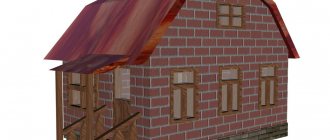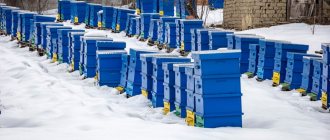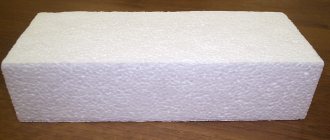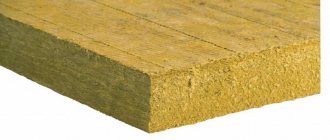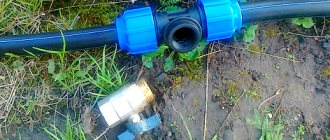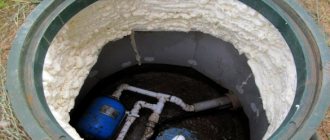The floor
The most difficult thing to do is the ceiling, the material falls down and is difficult to hold with your hands. You also have to attach it with staples and try not to twist it. I didn’t dare tape off the wiring and lamps and left a strip.
kitchen ceiling
I hung straw blinds on the wall in the room, and placed two carpet runners on top of the polyethylene floor. In general, it is customary to cover this polyethylene with something, i.e. the floor is hard covering (plywood, laminate), the walls are plasterboard or something similar. Everything is simpler and simpler for me, I didn’t hide anything. By the way, it’s not that easy to damage it and you can’t pierce it with your finger unless you try hard.
Result of use by season:
- The room temperature rises after turning on the heater in 15 minutes from 15 degrees to 24 °C. And it stays like that until you open the door.
- Polyethylene takes the temperature of the room, blocks heat from escaping outside, and does not allow drafts to pass through. Both the floor and walls heat up very quickly.
- If you remove heat leakage from the windows and front door, the result is excellent! When the outside temperature is 10 °C. at night, in the change house it was 20 ° C in the morning. and in a room with a heater at a minimum - 24 ° C. (without interior doors, which I removed).
This is a very good result of insulation, because without insulation, heating the room at full power and with the door closed, it was 20 ° C, and where there is no heater, the temperature was 12-15 ° C.
Thank you for your attention, I hope my experience will be useful. If you have questions, ask.
How to insulate a cabin, materials and methods
Buying a high-quality cabin is not a problem. Manufacturers offer a large number of models of various purposes, sizes and performance levels. This can be a simple structure to store materials or a small building that is fully prepared for habitation. However, the cost of such cabins is very high.
The ability to handle tools, plumbing and construction skills will allow you to make a change house with your own hands, and its cost will ultimately be several times lower than the options offered on the market. The frame is assembled from profiled metal; the outer cladding is best made from sheet metal or wood boards.
After completing the assembly of the load-bearing structure and securing the external cladding, it is necessary to carry out work on insulating the cabin premises. This will allow the room to be used for living in winter, and in summer the presence of insulation can protect against heat.
Features of gas connections
When connecting gas stoves, water heaters and other types of equipment, flexible hoses are also used. Unlike water models, they are yellow and are not tested for environmental safety. For fixation, end steel or aluminum reinforcement is used. There are the following types of devices for connecting gas appliances:
- PVC hoses reinforced with polyester thread;
- made of synthetic rubber with stainless steel braid;
- bellows, made in the form of a corrugated stainless steel tube.
The Santekhkomplekt holding offers engineering equipment, fittings, plumbing fixtures and devices for connecting them to communications. The assortment is represented by products and materials from well-known foreign and domestic manufacturers. Discounts apply for bulk purchases, and product quality is confirmed by standard certificates. For information support and assistance, each client is assigned a personal manager. The ability to arrange delivery within Moscow and to other regions of the Russian Federation allows you to quickly receive the purchased goods without unnecessary hassle.
Upon completion of the technological and production tasks associated with the arrangement of a sewer system in an apartment building, industrial building, as well as in a private household, it is necessary to test the involved system using the forced flow method. This task is used to identify possible defects or improper installation of the entire involved sewerage part, and the test report for internal sewerage and drainage systems will be material evidence of the work on acceptance of the facility.
A visual inspection should be accompanied by inclusion in the test report of internal sewerage and drainage systems according to SNIP, which is currently represented by the current regulations of the “D” series appendix, which corresponds to SP 73.13330.2012 “Internal sanitary systems of a building”, recently a new one has been applied updated working edition according to SNiP 3.05.01-85.
The change house belongs to the category of temporary technical structures that are installed at the site of construction work and serve to store various equipment, construction materials, as well as to locate working personnel there. As a rule, construction is carried out during the warm season. Then it may not be insulated. But if construction is delayed and moves into the winter, then it’s worth thinking about insulating the cabin.
After the construction of any objects is completed, the change house is most often dismantled due to its uselessness. But enterprising land owners often adapt it for other purposes.
After a little improvement, it can turn into an excellent bathhouse or a good country house, barn or other utility room. This is where the need for insulation of such a structure arises. Metal and wooden cabins are usually insulated from the outside and from the inside. We will consider these questions in more detail.
Materials for thermal insulation
In order to create sufficiently comfortable conditions inside the cabin at any time of the year, it is necessary to create an effective thermal insulation system inside the walls.
At the same time, its durability should be ensured subject to a minimum level of financial costs. High-quality thermal insulation will reduce the cost of heating the premises in the winter and create a cozy, warm environment in the cabin during cold weather. Of the variety of thermal insulation materials offered on the construction market, the most popular for thermal insulation of cabins are:
- mineral wool and basalt slabs;
- expanded polystyrene and polystyrene;
- polyurethane foam.
These insulation materials are easy to install, relatively inexpensive and have a low specific gravity. In addition to good thermal insulation properties, they will provide increased sound absorption and are not susceptible to rotting.
What you need to know about materials
There are several important parameters that must be taken into account when choosing insulation; below is a table with these characteristics.
Thermal conductivity is the amount of thermal energy that a material transmits through itself. The lower this indicator, the better the material retains heat and the smaller the layer will be needed.
Mats made of fluffed mineral materials, basalt wool
Mineral wool. Rolled material, the width of which is 1 m -1.2 m, the length is up to 10 m.
Mineral wool insulation is a traditional material for insulating cabins. Recommended mat thickness is 100 mm. To improve the quality of installation of the heat-insulating layer, you can lay the material in two layers of 50 mm each. In this case, the overlap of the joints between adjacent slabs will be ensured and there will be no possible cold bridges. Advantages:
- low price,
- ease of use,
- low level of heat loss,
- fire safety.
To protect against moisture and the formation of condensation, a wind barrier made of non-woven roll materials should be secured to the outer wall on the side of the change house. From the inside, provide a vapor barrier that will prevent the penetration of moisture from the warm room. Rolled penofol can be used as a vapor-repellent layer.
Foam boards
Polystyrene foam is sold in slabs of various thicknesses. From 0.5 to 2 m2. The lower the density of the material, the more efficiently it retains heat.
Polystyrene foam and expanded polystyrene are easy to install and are not subject to rotting or moisture. These materials have a low thermal conductivity coefficient and are very effective insulation. The grade of polystyrene foam for insulating cabins must be at least D40 (this is indicative of the relative density). It is best to use extruded polystyrene foam with overlapping locks on the end sides. Advantages:
- durability,
- moisture resistance,
- wind resistance.
Fixing foam plastic to a metal wall is done using special glue. The inner surface can be covered with plywood, plastic or other sheet material. The flooring is made using joists, between which insulation is laid.
Polyurethane foam
This material is sprayed onto the surface. After hardening, a dense foam forms. Can be used both inside and outside.
This insulation is more expensive than ready-made foam and mineral wool boards. It is supplied in cylinders, completely ready for use, or in the form of two chemical reagents, which are mixed immediately before use. The ability to expand during hardening ensures a high degree of sealing of cracks, joints and holes.
To fill the internal space of the wall and floor, two enclosing surfaces are required. The insulation can be supplied layer by layer or through holes in the partitions.
How to insulate the floor
A foil backing can be used as waterproofing for sweat insulation. It creates an additional effect. It can be used not only on the floor, but also on the walls.
To insulate the lower part of the cabin, any materials with waterproofing properties are suitable, these can be: basalt slabs, polystyrene foam, polyurethane foam and even bulk materials such as expanded clay. Do not use mineral wool as it will absorb moisture.
It is also necessary to use a water barrier. The air gap between the layers will create space for air circulation, which will prevent dew from forming.
We insulate the roof
This work can be done in two ways: insulate from the outside or from the inside. For external insulation, the thermal insulation material is selected taking into account its resistance to temperature changes and aggressive environmental influences. Such insulation materials include: polystyrene foam, mineral or basalt wool. From the inside, you can use any of the materials described above.
Basic requirements for installation
When insulating cabins, it is necessary to strictly observe certain conditions for the correct execution of work:
- all enclosing structures of the room, including the floor and ceiling, are insulated;
- it is necessary to ensure that there are no gaps at joints, in walls and in places where doors and windows are installed;
- the design of the walls must include ventilation holes to remove excess moisture from the insulation;
- when installing a change house in a position raised above the ground, it is necessary to cover the base to protect the lower part from additional heat loss;
- In places where heating equipment and appliances are installed, cover the walls with penofol or other reflective material.
To secure the insulation in the form of slabs and mats, wooden slats are installed, between which mats or slabs are laid. The interior wall can be made of plywood, fiberboard, chipboard or other sheet materials. The procedure for assembling an insulated wall is as follows:
- external cladding made of metal sheets or wooden materials is mounted on the finished frame of the cabin;
- a vapor-permeable, wind- and waterproof membrane is fixed on the inside of the casing;
- vertical wooden slats are installed;
- insulation is laid between the slats and covered with a vapor barrier layer;
- Internal decorative cladding is installed from sheet materials or wooden lining.
A variety of modern finishing materials allows you to create a beautiful, stylish interior inside the cabin.
Second stage: finishing
A finishing floor is installed on top of the insulation. There are two requirements for it: resistance to loads and a flat surface. The finishing of the floor in the change house is carried out using various materials:
- batten;
- plywood;
- OSB or chipboard.
If the premises are planned to be used as residential, then care should be taken to decorate the floor. For this, finishing materials are used: linoleum, laminate, parquet, ceramic or plastic tiles, carpet, etc. They are laid according to the instructions on the finished floor.
How to insulate a cabin for winter living
- Modules (51)
- Change house (29)
- Container (28)
- Buildings (23)
- Block container (19)
- House (18)
- Modular buildings (18)
- Construction (15)
- Marine (13)
- Foundation (9)
The need to insulate a cabin for winter living with your own hands arises to reduce the operating budget. By eliminating cold bridges, the user reduces energy consumption in heating systems and the number of registers/radiators in rooms. External thermal insulation is considered the only correct option. The insulation materials used must be compatible with the structural materials of the walls.
Materials for insulating cabins
A modular building is erected using the half-timbering method, which is a type of frame technology. The frame initially has internal cavities between the outer and inner wall cladding and the elements of the load-bearing frame. Therefore, insulation is usually placed inside the frame sheathing to reduce the cost per square meter.
In this case, all elements of the load-bearing frame, between which the heat-insulating material is laid, automatically become cold bridges. That is, the manufacturer seems to have insulated the modular cabins from the very beginning, but most of the thermal energy is spent on heating the street. That is why there is a need to improve the thermal contour of the building.
Requirements for insulation
Before insulating a trailer with your own hands for the winter inexpensively, you need to take into account a number of requirements:
- compatibility with wall and frame materials;
- layer thickness depending on specific thermal resistance;
- state of aggregation (loose expanded clay, ecowool, hard polystyrene foam, soft basalt wool).
In case of an error, at best, the repair budget will be wasted, at worst, the load-bearing frame will have to be changed, that is, the house will actually be demolished.
Bulk insulation made from cut paper impregnated with brown and boric acid has the following characteristics:
- not suitable for screeds, fits into cavities of walls, ceilings, floors;
- in its category it is considered the only material that repels insects and rodents;
- has a high operational resource;
- susceptible to caking over time - the formation of cold bridges at the junctions of walls/ceilings;
- moderately smoke-generating, flammable, combustible;
- capable of absorbing, retaining, evaporating 20% moisture as needed;
- thermal conductivity 0.04 W/mK;
- impregnated with antiseptic and fire retardant, does not rot, does not burn;
- at low density, vapor permeability is also low, only 0.3 mg/mchPa;
- It is considered a chemically passive medium with pH=8 and does not cause metal corrosion.
Ecowool is poured into wall cavities between sheet materials, stretched films, and membranes. The thickness of the layer is 10 - 15% less than that of basalt fiber and expanded polystyrene, respectively. With this material it is impossible to perform comprehensive insulation from the inside of a trailer if there is a flat roof, since there is no access to the ceiling from above.
Basalt fiber
The main disadvantages of basalt wool insulation are the lack of rigidity and loss of properties when wet. The material cannot be laid in a screed; after getting wet, it will have to be dried to restore its characteristics. The main properties of stone wool are:
- thermal conductivity about 0.037 W/mK, vapor permeability 0.3 mg/mchPa;
- the material does not burn, melting point +870°C;
- the density is low, subsidence in the walls is possible.
This insulation is considered the best option for wooden cabins. The lumber from which the racks, crossbars, and floor beams are made inevitably absorbs moisture from the rooms. Mineral wool makes it easy to evaporate back because it has high vapor permeability.
Basalt fiber is safe for steel structures; you can insulate a metal trailer from the outside or inside.
One of the few insulation materials that retains its properties even when completely immersed in water is polystyrene foam. The material is cheap, but it crumbles a lot when working with it and breaks down over time. A better analogue of polystyrene foam is polystyrene foam:
- extruded XPS boards are used to insulate foundations under the sole and outside;
- self-extinguishing pressless PSB-S is used for thermal insulation of building envelopes.
Polystyrene foam is incompatible with wooden structures, which have nowhere to evaporate excess moisture absorbed by the wood from the air. The posts and beams of the frames begin to rot after a year if this insulation is laid between them.
Expanded polystyrene has high rigidity, does not sag or fall off in the walls. It can be laid in ceilings and inexpensively insulate the floor of a cabin. The material is flammable, SNiP/SP standards prohibit its use on facades around door and window openings.
Insulation for cabins
Currently, any specialized retail outlet can offer a large assortment of insulation materials that have their own properties and qualities. Let's look at the main ones:
It is easy to install, light weight, there is no need to strengthen the load-bearing structures of the cabin, and can be processed with any available tools. It has such positive qualities as fire resistance, moisture resistance, durability, and is resistant to significant temperature changes. There are few disadvantages, but they exist: it is difficult to fill certain recesses and does not fit well with rounded structures, the sheets are of significant rigidity and practically do not bend. This can create condensation in the recesses and the wooden structures will become covered with fungus. Metal elements can be affected by corrosion.
As for expanded polystyrene, it is afraid of paints and varnishes and drying oil, which can dissolve it. Direct sunlight negatively affects the condition of this material, even to the point of complete destruction. To avoid these negative consequences, polystyrene foam must be plastered on top with cement.
There are foam plastic sheets that are not at all suitable for insulation purposes and they cannot withstand winter frosts. These sheets are most often used to pack household appliances for transportation. The best manufacturers of this material are considered to be Technonickel and Penoplex, Bast, Polimeri Europa, Styrochem.
This insulation consists of fibers arranged randomly. They are made of slag, glass, and stone. Slag wool is not environmentally friendly compared to other options, but special gloves are not required for its installation, and it will not harm your hands. This material is fire resistant, sufficiently soft and durable. In the summer months it does not allow heat to pass through, and in the cold winter it retains heat inside. It is famous for its high vapor permeability coefficient.
The service life is quite long and ranges from 25 to 50 years. If you decide to use glass wool, you must follow safety rules when working with it and use special gloves. This material is mainly used in manufacturing processes. Slag wool can be found quite rarely, but stone wool is very popular. The presence of basalt in it helps to increase the thermal insulation properties significantly.
This material is completely safe for humans: it does not burn and does not deform. Its cost is significant. Special fastening for mineral wool is not purchased. It fits tightly under the frame slats. All voids can be filled with mineral wool, which is why summer residents prefer it when insulating their cabins.
Reduces noise well. The disadvantage is its high flammability, so before installing it it is worth impregnating it with fire retardants. It is quite difficult to attach, but it holds the heat perfectly.
Positive characteristics include: there is no need to equip waterproofing layers, since it is not afraid of moisture, excellent thermal conductivity, low weight, low cost, long service life. It can be classified as a high-strength, anti-radiation, antibactericidal material. Retains its high vapor permeability throughout its entire service life (about 100 years). Easily processed with hand tools.
It is worth dwelling on the following advantages: low coefficient of thermal conductivity, non-flammability, high antiseptic properties (prevents mold and fungi from multiplying), sufficient elasticity, antistatic and absorbs noise well. They insulate both internal and external surfaces.
A fairly environmentally friendly material with a long service life, reaching more than half a century. It does not grow mold and mildew, it is not popular with rodents and insect pests, which contributes to its complete safety throughout its entire service life. It practically does not burn, but when nearby objects ignite, it can maintain combustion.
Step-by-step instruction
The main problem of inventory buildings is the limited usable area. They are transported ready-made; the external dimensions have to be linked to the width of the roadway, the height of tunnels and bridges, power lines, and the length of the trailer. From the point of view of building physics, external insulation is preferable. Therefore, step-by-step instructions are given for a ventilated facade, with which the iron trailer will be both insulated and decorated.
Floor insulation
Unlike a permanent building, a winter shed has a special operating mode and design features:
- the foundation is lightweight or completely absent;
- the building is mobile, there is no rigid connection with the ground;
- there is no base, it is necessary to make a pick-up;
- engineering systems should be additionally insulated;
- The size of the house is small, it will not be possible to use the geothermal heat of the subsoil.
In factory conditions, you can turn the dacha cabin on its side, then turn it over with a crane to the other side to insulate the floor from the outside. After installation on the site, only one method of insulation is available - from the inside.
Ceiling insulation
Change houses usually have a flat roof without an attic, so the ceiling is always insulated from the inside. The exception is multi-module buildings made from cabins. Here a gable roof appears; thermal insulation material is laid on the ceiling from above, from the attic side. The main difficulties of the technology are:
- foam plastic, mineral wool is difficult to fix on the ceiling;
- materials do not have their own decorative layer;
- The ceiling height in the change house is less than in permanent buildings.
To solve these problems, a sheathing made of timber is attached to the floor beams. The insulation is laid on top of the sheathing or fixed inside the cells. Sheet and slab material is hemmed underneath. Fiberboard, chipboard, and plywood do not have their own decorative layer, so they are additionally lined with polystyrene panels, wallpaper, or painted with paints and varnish. Fiberboard, MDF and some other materials have a front layer; they do not need to be finished. The slabs and sheets are fastened to the sheathing with screws or staples.
Wall insulation
For additional thermal insulation of the walls of a cottage used in winter from a cabin, ventilated facade technology is used:
- manufacturing a frame from a bar or galvanized profile, the racks are mounted on brackets;
- fastening polystyrene foam boards to the wall in a continuous layer without gaps;
- covering the thermal insulation layer with windproof film;
- covering the frame with corrugated sheets, siding, clapboard, panels, block house.
In 90% of cases, cabins are mounted on pile, columnar foundations. In this case, an additional fence is made - a false base, decorating the gap between the walls and the ground, protecting the underground from blowing. There are two options for the design of the fence:
- laying ¼ - ½ brick around the perimeter of the building;
- sheathing with sheet material on a frame made of metal profile.
In turn, the facing of the fence is protected from destruction by the blind area. It makes no sense to insulate the back wall or blind area, since there are no heat sources in the underground and the soil freezes completely.
If the change house stands on slabs or a shallow strip foundation, additional insulation of three elements will be required - the foundation, the plinth and the blind area. During temporary, all-season operation of the building, these structures become large-sized cold bridges. Therefore, the insulation layer should smoothly transition from the walls to the base, then the outer walls of the foundation, and continue horizontally under the blind area.
Window insulation
Modern cabins are equipped with double-glazed window units. Therefore, there is no need to insulate them additionally. It is enough to choose the right number of cameras for the region of operation. The change house is a frame structure, the wall here is multi-layered, so the window block can be shifted in any direction relative to the plane of the external/internal walls.
Cold bridges are eliminated by polyurethane foam around the perimeter; freezing of the wall does not occur, since the entire wall is lined with insulation from the inside. The most vulnerable element of a window unit is glass, through which the main heat loss from the room occurs. Therefore, in cabins with large windows there will always be more heating registers than in inventory buildings with small frames.
General rules for thermal insulation
To properly insulate a wooden outbuilding, certain rules are followed.
- First, we prevent heat loss through the roof - we cover the structure with a special film. Only after this can the roof be laid in the form of corrugated sheets or ondulin.
- To increase heat resistance, MDF panels are used, installed on special profiles. We fill the free space with a heat insulator of your choice.
Change houses made of metal are highly resistant to mechanical and other influences. The metal frame is completely protected from moisture by a special covering. But the roof of an outbuilding is often susceptible to corrosion processes. To prevent corrosion, it should be treated with a polymer-based coating or paint and varnish products.
Wall structures are sheathed with clapboard, block house or plastic panels. Thermal insulators are mineral wool or polyurethane foam. To prevent heat loss, cracks and joints are sealed with tongue and groove boards. Combined outbuildings are insulated in the same way.
Where to start insulating a cabin
If you are just planning to purchase a cabin for winter living, then first of all you need to pay attention to the material from which the structure is made. There are three main types of cabins: metal, wood and combined
- The metal structure is a frame covered with profiled galvanized iron. The design is resistant to moisture penetration and therefore exhibits better heat retention ability.
- A wooden change house is very vulnerable to the penetration of cold and moisture into the room, and therefore requires more careful thermal insulation.
- A combined cabin is a structure made from several materials. Insulation must be carried out taking into account the material of the cabin in its individual areas.
Heating of the cabin
Organizations use trailers as mobile buildings. When moving frequently, it is impossible to use stoves and boilers using liquid or solid fuels. Electric heaters are used in the rooms. Private owners, on the contrary, buy inventory buildings for use in one place without transportation between objects. Therefore, metal cabins for summer cottages are often heated by a stove using wood, pellets, or briquettes.
With small dimensions of the building, air heating from the stove is quite sufficient. If the house is assembled on the SNT/ONT site from several trailers, it makes sense to install a boiler and extend water heating circuits.
Thus, the walls of cabins are usually insulated from the outside using ventilated facade technology. Thermal insulation in the floor, the ceiling is laid from the inside of the building. The heating option is developed individually depending on the operating conditions of the building.
How much will an insulated cabin cost?
The cost of such a design with insulation may vary on the domestic market. It all depends on the size of the structure, the material used to insulate it, the presence of a stove, etc. The average price for an insulated container in the Russian Federation can be about 100,000 rubles. In this case, the buyer can choose designs of different shapes.
A country house can be:
- Frame.
- Shield.
- From logs.
- From timber and others.
What types of cabins are there?
To install a wooden cabin, you do not need a foundation.
The cabins, insulated for the dacha, differ both in the material used and in their design. They are united by one feature - the absence of a foundation. In some cases, contractors offer to install the shed on a pile foundation, but often they are placed on low pads. The main thing is that there are no distortions; everything should be done according to the water level.
Wooden cabins, insulated for dachas, are:
- panel;
- frame;
- from timber;
- from a log.
Insulated dacha cabins made of metal are either a container or a trailer; there are even cabins from old buses. Sometimes the possibilities are limited only by your imagination. Such mini-rooms are needed to store equipment, change clothes and keep warm. Often, cabins are equipped with heating. Electric heaters, stoves and potbelly stoves, gas or liquid fuel heaters are suitable for this purpose.
An insulated change house with a stove can be used in the winter without any problems.
It is an integral part of any construction site. Workers not only change clothes and have lunch in it while on business trips, they live there. Of course, the lack of water, sewerage and a bathroom cannot but create inconvenience, but in the absence of an alternative, an insulated winter cabin is quite suitable for temporary living. If the size allows, it can be divided into several rooms in which it is quite possible to create minimal amenities.
Do-it-yourself materials for insulating a cabin
A winter dacha cabin should be warm even in severe frosts, especially if these are residential trailers for living. It is important to thermally insulate everything in such a design:
Different materials are used for such work. The most popular is polystyrene foam. Such thermal insulation does not cause allergies, does not absorb moisture, can last a long time if installed correctly, and is also non-flammable.
- Moisture resistance.
- Durability.
- Not afraid of temperature changes.
- Does not burn.
The downside of the material is that it is quite difficult for them to finish round bases. Its sheets do not bend. Therefore, pockets of air may remain under the panels, which will cause moisture to accumulate there. This can lead to rotting of the frame.
Before choosing polystyrene foam, you should familiarize yourself with its parameters, since with the help of certain types it is impossible to properly insulate a trailer for living there in winter. It is recommended to purchase polystyrene foam brand PSB-S40.
Experts also advise not to use polystyrene foam to insulate the trailer from the inside. Although it does not burn, when heated it melts and releases toxins into the air that are harmful to humans.
This substance has improved thermal insulation quality and does not burn.
- The material is soft but durable.
- Does not burn.
- Retains heat and keeps out cold.
- The vapor permeability coefficient is high.
- Can last an average of 20 years if installed correctly.
When working with such material, it is important to follow the rules. Activities should be carried out in protective equipment.
To install the thermal insulator, you will need to first build a frame made of wood or aluminum. Many summer residents prefer mineral wool for insulation, but it costs more than polystyrene foam.
Cotton thermal insulator
This substance is the safest for today. It is high quality and environmentally friendly. Can be used to insulate walls inside a trailer and does not require special installation skills. It is often used for thermal insulation of cabins in which it is planned to live. The downside is that the product is difficult to cut.
Thermal insulation materials
The range of materials for thermal insulation is quite wide. To make a choice, it is important to know their features.
Polyurethane is the best material for insulating buildings, since its use leaves no gaps or joints, which ensures maximum tightness.
Polystyrene foam is one of the most affordable insulation materials. It is usually used to insulate the walls of wooden buildings, including cabins. Polyfoam is easy to install and resistant to moisture. But it is worth noting that if the technology for laying the material is not followed, its service life is reduced. If polystyrene foam is chosen as insulation, special attention should be paid to its quality: low-grade products usually crumble.
Mineral wool has unsurpassed thermal insulation properties. It is fire resistant. Mineral wool allows not only to insulate a building, but also to improve its sound insulation. To achieve an excellent result, it is important to correctly calculate the required thickness of thermal insulation.
Basalt fibers are commercially available in the form of slabs. To make them, the remains of basalt rocks are processed. Such insulation does not deform during operation and does not support combustion. To insulate a cabin using basalt fiber, it is enough to use a thin layer of material. Disadvantages include seams that are formed as a result of installation, but they can be sealed.
Step-by-step instructions for insulating a cabin
Work can be carried out both inside the trailer and outside. These methods have both positive and negative aspects. Insulating the cabin from the outside will preserve its internal volume . This will also protect the walls of the building from the effects of external negative factors, which will extend the life of the trailer. The downside of insulating the cabin from the outside is that it will then have to be finished with decorative material to make it look attractive.
- A frame is installed on the wall.
- The space between the beams is filled with cotton wool.
- A layer of waterproofing is laid.
- Facing.
Preparation
You will need to prepare the following materials and tools:
- Vapor barrier.
- Minvata.
- Beam.
- Mastic for wood processing.
- Hammer.
- Screws.
- Nails.
Floor insulation
How to insulate the base of a cabin with your own hands? For such work you can use:
How to insulate a trailer for winter living on top? It is recommended to carry out such work outside. To do this, you need to remove the roofing material (slate), lay waterproofing and insulation under it. Then attach the roofing material back.
Arsenal of tools for work
Insulating a cabin on your own requires not only skills, but also an appropriate set of devices and tools:
- base profile;
- hammer;
- reinforced mesh;
- building level;
- scaffolding or trestles if the ceilings are high;
- perforator;
- metal spatula;
- containers for solutions and gloves;
- knife, saw and foam grater.
You may also need disc-shaped dowels, putty, glue, polyurethane foam, primer and the thermal insulation material itself. The above list is not exhaustive; during the work process, the master may need other tools, it all depends on the chosen thermal insulation technology.
